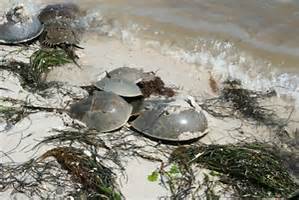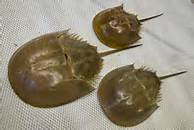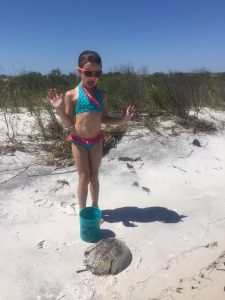This is an interesting animal that I did not see a lot in the Pensacola area growing up, but more people do see now. The horseshoe crab is not a crab at all, but rather a cousin of the spiders and scorpions. They lack the classic 10 legs that crustaceans have and the 2 sets of antenna. Instead, they have seven pairs of legs and no antenna – much more like the spiders and scorpions, but not exactly the same.

Photo: Florida Sea Grant
There are fossil forms of this animal going back 445 million years. Out lasting two mass extinctions, it is one of the oldest animal forms still alive on this planet. There are actually four species of the animal still on the planet: the Japanese horseshoe crab, the Chinese horseshoe crab, the Indonesian horseshoe crab, and the American horseshoe crab. The American horseshoe crab (Limulus polyphemus and here after referred to as the horseshoe crab) is found along the Atlantic and Gulf coast shores of the United States, and in very low numbers along the Yucatan peninsula. On U.S. shores, its greatest numbers are found in Delaware Bay. Here their breeding numbers on the shores can number in the thousands. Along the shores of the Big Bend region of Florida, you can find breeding numbers in the hundreds. In the Pensacola Bay region you are lucky of you find one, however… people are – mostly in the Pensacola Beach area, but they have been seen in Big Lagoon as well. Two mating pairs have been reported in the Pensacola Beach area, and this is pretty cool news.
How would I know a horseshoe crab if I saw one?
Well… unless you are from the Mid-Atlantic region, your first response when seeing one would probably be – “what is that thing”? They sort of resemble a stingray. The head is literally horseshoe shaped, with a small flat tail region and a long spine (called a telson) extending behind. Many will pick the animal by this telson, but please do not – it can do damage to them. Though it looks like a stingray, the telson is completely harmless and is used to flip themselves over when the waves overturn them on the beach. Actually, the claws beneath the shell are harmless as well – many marine educators have allowed young kids play with the claws to show them this – it actually tickles a little. While monitoring horseshoe nesting on the beach in the Mid-Atlantic region, a researcher observed a couple walking down the shore towards her. Curious as to how they would react when they saw the horseshoe crabs on the beach, she witness the man grab a stick and begin to beat them. She quickly called out and asked why he did that – his response was that they were ugly. So I guess they are ugly, but please do not kill them – they really are harmless.

Photo: Scott Jackson, UF IFAS
Actually… they have benefited us all with a unique component of their blood. Many years ago, scientists discovered a compound in their blood we call Limulus Amebocyte Lepate (LAL). This compound clots when in the presence of endotoxins produced by bacteria. Thus all medical supplies, from implants, to pic lines, to needles, are checked against this LAL to be sure there is no bacteria in contact before they use it on patients. Each person reading this has probably benefitted in some way from horseshoe crab blood.
The natural history of this animal is really interesting. They actually have 10 eyes. Two are compound eyes that provide them with vision they need. Compound eyes have more than one lens but instead of seeing multiples images of you, each lens forms a pixel of a larger image. Have you seen on television when they are trying to block out an advertisement on someone’s shirt, or a license plate number? Crabs see the whole world this way. It does not produce a very clear image of you but is VERY good at detecting motion from the individual. The vision range is about three feet. The other eight eyes only have a single lens, as ours, but they detect light – knowing whether it is night or day (and they prefer to move at night) – and some underneath that will help let them know when they have been flipped upside down by waves when they are nearshore in the surf.
Horseshoe crabs plow through the soft muds of the seafloor searching for small invertebrates to eat. They prefer low energy environments, such as Big Lagoon and Santa Rosa Sound, to the open Gulf of Mexico – but they do venture out onto the continental shelf.

Photo: provided by Carrie Stevenson
Breeding time is when most will see them. Breeding occurs on the beach, at night, during the high tide of a full or new moon. In the Mid-Atlantic, they breed during May and June, in Florida it can be year round. The smaller males approach the beach first. Males can be identified by the first pair of legs, which look like a fist and are used to hold on to the females shell when breeding. They lie awaiting for the larger females. Within a few hours of high tide, the females begin to approach the beach. The males quickly swarm around her hoping for the chance to fertilize her eggs when she buries them in the sand. As she approaches, one lucky male will be the first to hook himself onto her shell. She will carry him around until she actually releases the eggs, which could be days. However, other males – known as satellite males – will continue to follow. When the females releases her eggs (about 4-6” beneath the sand), she does so at the surf zone. The hooked male will try to fertilize with his sperm but the wave action will toss gametes all over the place – so nearby males releasing their sperm may still have a chance to fertilize some eggs. When there are few satellite males around, many of the eggs are actually fertilized by the satellites – the more satellites, the less their success.
Females know where the best nesting beaches are, but we do not. SO, if you witness this – please contact me at the Escambia County Extension Office and let me know. I do not know how common horseshoe crabs were in the Pensacola area decades ago but do know old time residents have told me they were around. As a matter a fact, a long time resident of Pensacola Beach told me, the submerged “island” in the middle of Little Sabine was exposed decades ago and was called Horseshoe Crab Island because they were so common there – it was near here that a hooked male/female pair was seen this year.
It would be really cool if these ancient mariners made a comeback in our area. I hope you get to see one and please let us know if you do.
Reference
Fredericks, A.D. 2012. Horseshoe Crab; Biography of a Survivor. Ruka Press, Washington D.C. pp. 256.
 0
0
